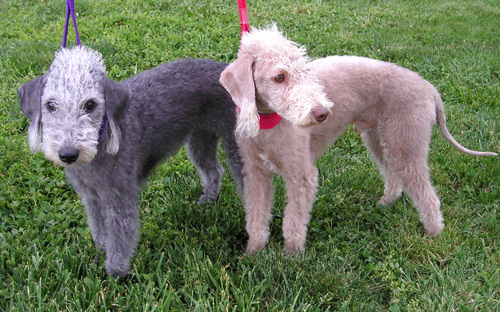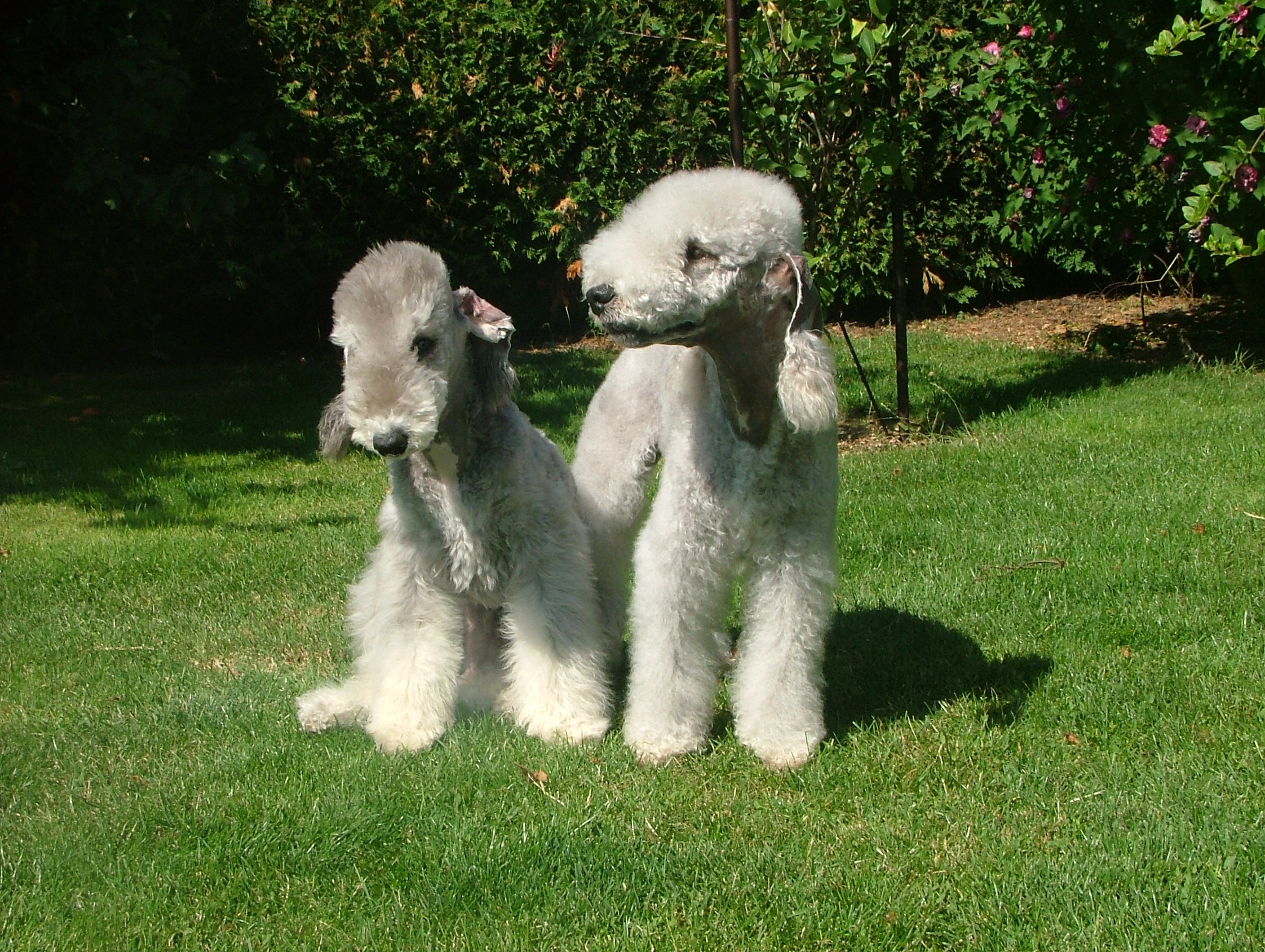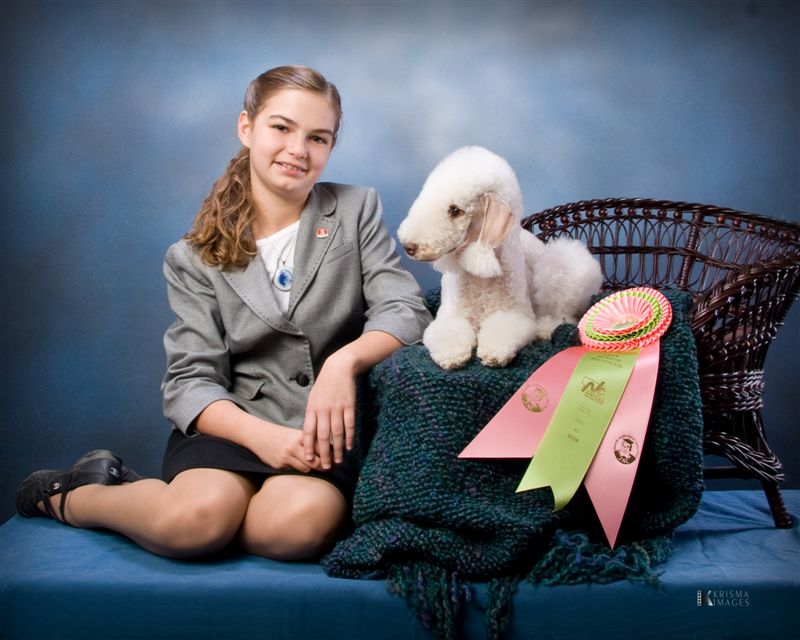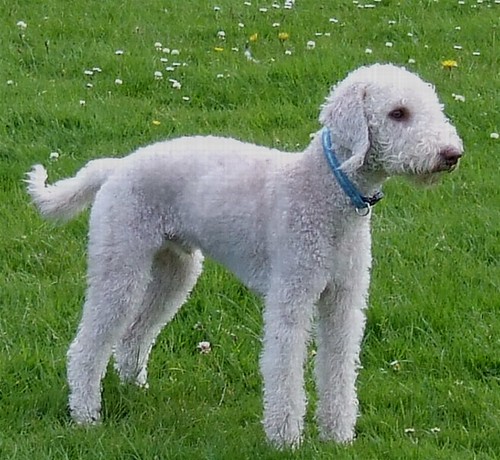The Bedlington Terrier is a breed of terrier named after the mining town of Bedlington, Northumberland in North East England.
Description
Appearance: The Bedlington Terrier is often described as looking like a lamb on a leash, probably because it has non-shedding fur with a woolly texture. These dogs may be blue, sandy, liver, or dark brown/black and sable and can be solid colours or have tan markings.
This breed has a wedge-shaped head with sparkling, triangular eyes.Its body shape, however, is unusual for a terrier, being somewhat like a Greyhound in construction, which enables it to gallop at great speed. However, the front legs are constructed differently from those quick hounds in that, the front legs are closer together at the feet than at the elbows - creating a triangular shape when viewed from the front. This enables them to turn or pivot quickly when chasing quarry at high speed. They are groomed with long hair left on the top of their skull and muzzle, tassels on the ears and slightly longer furnishings on the legs than the body coat.The quarry, trying to escape, would bite at the dog, and the hair saved the Bedlington from an injury to the important facial area and possible death from an infection. A similar idea is seen in the tail, crest and wings of the Secretary Bird.
Description
Appearance: The Bedlington Terrier is often described as looking like a lamb on a leash, probably because it has non-shedding fur with a woolly texture. These dogs may be blue, sandy, liver, or dark brown/black and sable and can be solid colours or have tan markings.
This breed has a wedge-shaped head with sparkling, triangular eyes.Its body shape, however, is unusual for a terrier, being somewhat like a Greyhound in construction, which enables it to gallop at great speed. However, the front legs are constructed differently from those quick hounds in that, the front legs are closer together at the feet than at the elbows - creating a triangular shape when viewed from the front. This enables them to turn or pivot quickly when chasing quarry at high speed. They are groomed with long hair left on the top of their skull and muzzle, tassels on the ears and slightly longer furnishings on the legs than the body coat.The quarry, trying to escape, would bite at the dog, and the hair saved the Bedlington from an injury to the important facial area and possible death from an infection. A similar idea is seen in the tail, crest and wings of the Secretary Bird.
Temperament
Calmer and less boisterous than many other terriers, the Bedlington Terrier is known as a dog with a good nature and mild manners.In addition, it is fast enough to bay a badger or a fox and is a first-rate water dog. Incredibly smart and attentive to its owner, the Bedlington is one of the most reliable terriers. They are problem solvers and loyal family companions.
Although Bedlington Terriers resemble lambs with their thin tails and fluffy white fur, they can be vicious. If left alone with nothing to do, they can become destructive and need plenty of excercise. However, with firm, loving handling and plenty of excercise they can make cheerful, lovely companions.
Care
Grooming
Weekly combing and professional grooming are needed every 6-8 weeks to keep their coats (which tend to curl) in good shape. Dogs being prepared for the show ring often have much more hair left on them than those in "pet clips," which provide pet owners with a more manageable trim for their pets. The show trim is entirely hand-scissored, with the exception of the ears, face/throat, belly and tail which are trimmed with an electric clipper. It can take years to master the grooming pattern for this breed.
Exercise
These high-energy dogs need several vigorous walks and aerobic play sessions daily to keep them happy and content. The breed is well suited for agility, earthdog, obedience and other performance events.
Hypoallergenic qualities
Bedlington Terriers often appear on lists of dogs that do not shed (moult),but this is misleading. Every hair in the dog coat grows from a hair follicle, which has a cycle of growing, then dying and being replaced by another follicle. When the follicle dies, the hair is shed. The length of time of the growing and shedding cycle varies by breed, age, and by whether the dog is an inside or outside dog. "There is no such thing as a nonshedding breed."The grooming of the Bedlington helps remove loose hair, and the curl in the coat helps prevent dead hair and dander from escaping into the environment, as with the poodle's coat. The frequent brushing and bathing required to keep the Bedlington looking its best removes hair and dander and controls the other potent allergen, saliva.Although hair, dander, and saliva can be minimized, they are still present and can stick to "clothes and the carpets and furnishings in your home"; inhaling them, or being licked by the dog, can trigger a reaction in a sensitive person.
Bedlington Terrier circa 1915
History
The famed progenitor of Bedlington was a dog named "Old Flint", whelped in 1782 and owned by "Squire Trevelyan." Originally, the breed was known as the "Rothbury" or "Rodbery Terrier." This name derived from a famous bitch brought from Staffordshire by a company of nail makers who settled in Rothbury. The Terriers of this section were accustomed to rodent hunting underground, and worked with packs of foxhounds kept there at the time.
It is suggested that the Bedlington may well have made its way to Ireland and played a part in the early development of the Kerry Blue Terrier.
The first Bedlington Terrier club was formed in 1877. The Bedlington Terrier was recognized by the United Kennel Club in 1948.
Ch. Femars' Cable Car, descendant of Ch. Rock Ridge Night Rocket winner of best-in-show at the Westminster Kennel Club Dog Show in 1948, was featured on the cover of Sports Illustrated in the February 8, 1960 edition.
The famed progenitor of Bedlington was a dog named "Old Flint", whelped in 1782 and owned by "Squire Trevelyan." Originally, the breed was known as the "Rothbury" or "Rodbery Terrier." This name derived from a famous bitch brought from Staffordshire by a company of nail makers who settled in Rothbury. The Terriers of this section were accustomed to rodent hunting underground, and worked with packs of foxhounds kept there at the time.
It is suggested that the Bedlington may well have made its way to Ireland and played a part in the early development of the Kerry Blue Terrier.
The first Bedlington Terrier club was formed in 1877. The Bedlington Terrier was recognized by the United Kennel Club in 1948.
Ch. Femars' Cable Car, descendant of Ch. Rock Ridge Night Rocket winner of best-in-show at the Westminster Kennel Club Dog Show in 1948, was featured on the cover of Sports Illustrated in the February 8, 1960 edition.
Health
Mortality
Median longevity of Bedlington Terriers, based on two recent UK surveys, is about 13.5 years,which is longer than for purebred dogs in general and longer than most breeds similar in size.The longest-lived of 48 deceased dogs in a 2004 UK Kennel Club survey was 18.4 years. Leading causes of death among Bedlington Terriers in the UK were old age (23%), urologic (15%), and hepatic (12.5%).The leading "hepatic" cause of death was copper toxicosis. Dogs that died of liver diseases usually died at a younger age than dogs dying of most other causes.
Morbidity
Bedlington Terrier owners in the UK reported that the most common health issues among living dogs were reproductive (primarily of concern to breeders), heart murmur, and eye problems such as epiphora and cataracts. Copper toxicosis occurred among about 5% of living dogs.
Copper Toxicosis; Copper Storage Disease
Bedlington Terriers have an unusually high incidence of copper toxicosis, an inherited autosomal recessive disease, characterized by accumulation of excess copper in the liver. Genetic testing is now available. The disease is diagnosed with a liver biopsy.It is essential that anyone interested in purchasing a Bedlington is provided with proof of the dogs' unaffected status.






No comments:
Post a Comment